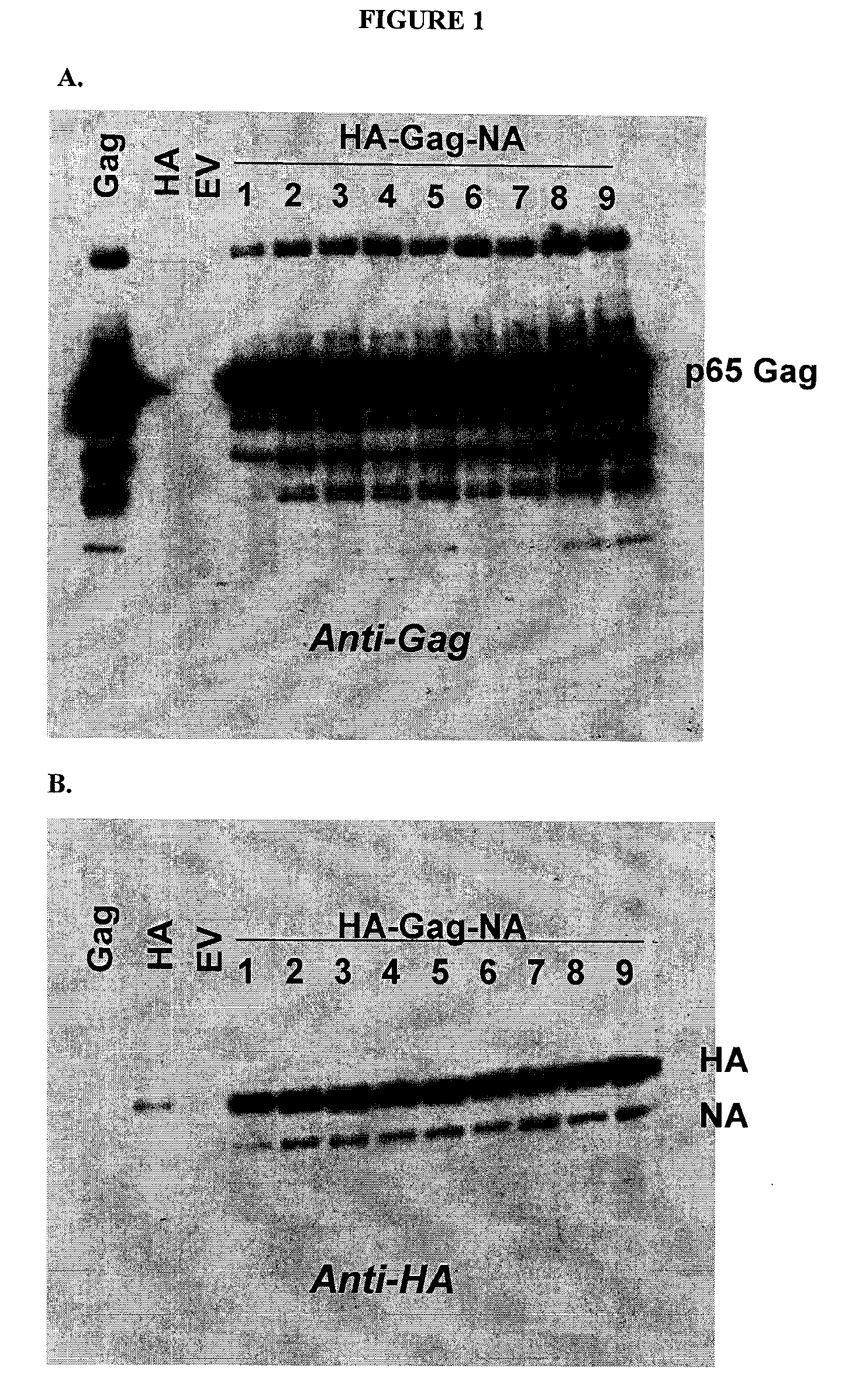Chimeric influenza virus-like particles
a technology of influenza virus and similar particles, applied in the field of influenza viruslike particles, can solve the problems of limited or no protection of antibodies inability to prepare advance stockpiles of well-matched vaccines against pandemic threats, and inability to protect against one type or subtype of influenza virus. to achieve the effect of enhancing immunogenicity
- Summary
- Abstract
- Description
- Claims
- Application Information
AI Technical Summary
Benefits of technology
Problems solved by technology
Method used
Image
Examples
example 1
Production of a Chimeric Influenza VLP
[0128]The MLV gag coding sequence was obtained by PCR from plasmid pAMS (ATCC) containing the entire Moloney murine leukemia virus amphotropic proviral sequence. The gag coding sequence was inserted into pFastBac1 (Invitrogen) behind the polyhedron promoter and the resulting plasmid was transformed into DH10Bac competent cells for recombination into the baculovirus genome. High molecular weight bacmid DNA was then purified and transfected into Sf9 cells for generation of a gag-expressing recombinant baculovirus. Two other recombinant baculoviruses encoding the hemagglutinin and neuraminidase, respectively, of A / PR / 8 / 34 (H1N1) were produced in a similar fashion after RT-PCR cloning of the HA and NA coding sequences from virus RNA. Finally, a single baculovirus vector encoding all three products (HA-gag-NA) was produced by combining the HA, gag, and NA expression units (polyhedron promoter—coding sequence—polyA site) from individual pFastBac1 plas...
example 2
Intranasal Delivery of Chimeric Influenza VLPs
[0131]The HA-gag-NA VLPs were prepared from the medium of Sf9 cells infected with a triple expression baculovirus vector encoding MLV gag and the HA and NA products of influenza virus A / PR / 8 / 34. Medium was harvested when cell viability dropped below 10% and was clarified of cell debris by centrifugation at 2000 rpm for 15 minutes. Forty ml of clarified medium (5 ml per MLA-80 ultracentrifuge tube) was layered over 1 ml 20% sucrose cushions in tris-buffered saline (TBS), pH 7.4, then centrifuged at 45,000 rpm for 2 hours at 10° C. in a MLA-80 rotor. The pelleted material was resuspended in TBS and layered over 20-60% sucrose step gradients and centrifuged at 36,000 rpm for 2 hours at 10° C. in a MLA-80 rotor. Gradients were fractionated into 0.5 ml fractions and assayed for the presence of p65 gag on SDS-PAGE gels. Pooled fractions containing VLPs (approximately 3 ml from two gradients) were concentrated and buffer exchanged into TBS usin...
example 3
Production, Characterization and Immunogenicity Testing of HA-gag-NA VLPs
[0134]As described in the Example 1, individual baculoviruses expressing MLV gag and the HA and NA products of A / PR / 8 / 34 have been produced. In addition a triple expression recombinant baculovirus encoding all three products has also been constructed and sucrose density gradient centrifugation of pelleted medium supernatants from infected insect cells showed coincident banding of gag and HA as detected by Western blotting indicating that VLPs with HA had formed. The arrangement of coding sequences in the triple expression vector is shown in FIG. 4 in which the HA, gag, and NA coding elements are arranged in a head-to-tail fashion, each with its own promoter (Pr) and polyadenylation sequence (pA). Combining all coding sequences into a single baculovirus avoids the need to perform co-infections with separate viruses and the associated difficulties of achieving consistent multiplicities of infection of three separ...
PUM
| Property | Measurement | Unit |
|---|---|---|
| Composition | aaaaa | aaaaa |
| Immunogenicity | aaaaa | aaaaa |
| Covalent bond | aaaaa | aaaaa |
Abstract
Description
Claims
Application Information
 Login to View More
Login to View More - R&D
- Intellectual Property
- Life Sciences
- Materials
- Tech Scout
- Unparalleled Data Quality
- Higher Quality Content
- 60% Fewer Hallucinations
Browse by: Latest US Patents, China's latest patents, Technical Efficacy Thesaurus, Application Domain, Technology Topic, Popular Technical Reports.
© 2025 PatSnap. All rights reserved.Legal|Privacy policy|Modern Slavery Act Transparency Statement|Sitemap|About US| Contact US: help@patsnap.com



